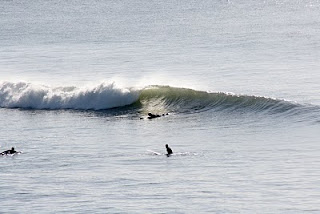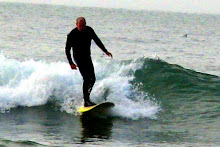
| Bolinas | Groin |
| 9:15 am to 11:10 am | 3' to 5', sets overhead |
| High tide (6.8 ft at 11:00 am) | No wind |
| Overcast | Good session |
Conditions were good this morning. The last remnants of the first big north swell of the season mixed with a little bit of south swell: 6 ft NW swell at 13 seconds, 3 ft south swell at 14 seconds, no wind, upcoming tide and glassy conditions.
“Hey Loren, watch out for the flotsam. It’s dangerous out there,” Dan greeted me as he came up the ramp.
“The what?”
“The crap in the water. I almost hit a log floating in the water at the Patch.”
The power of the ocean is always amazing. The big swell of this past week had deposited mountains of debris on the beach and had removed tons of sand. A major section of a pier lay on top of the sand berm near the high tide line. A twelve-foot long 9 x 9 inch beam connected two telephone size pilings. This thing had to weigh two tons. How could the ocean push a thing of this size around? There must be a good story here. Where did it come from? How far did it travel? Did a storm literally destroy a major pier? And how long had it been in the water? Several small tree trunks and large pieces of weathered plywood surrounded the pier section.
I paddled out at the Groin to join Martha and Sarah who drives the gold Mercedes. David who rides the Becker board and Mark the archaeologist were further south at the Channel peak. The waves were much bigger and more powerful than they looked from the overlook. I knew they were difficult to catch so I sat inside to take off late. A good wave was cresting when I turned to go for it. I stroked into it as it was breaking, dropped down a head-high wave, fizz sounded from my rail cutting into the curl, I turned left and looked down a line that was feathering ten feet in front of me. I leaned into it, crouched down and shot through the first section and pushed out onto the shoulder. I cut back into the breaking part of the wave to let it build up, turned left again into a fast inside curl and cruised along until the wave sucked out near the Groin wall. At that moment I knew I was in for an exciting session.
The waves were steep, powerful and fast. But there was a dead spot in the middle of the break that was both positive and negative. Positive in that the dead spot, which was an area of deeper water, caused all the waves to break to the left. The initial peak would pitch over and peel towards the deeper water. The dead spot also provided a good channel for paddling back out. The negative was it was truly a dead spot. I would sail down the initial section and coast into the dead spot where my momentum and the wave would die. I learned quickly that I had cut back into the breaking part of the wave after the initial drop to stay in the wave. If I could stay in the wave, it would reform into a steep and fast inside curl.
A skilful stand-up surfer, who was always paddling around way outside at the far Channel peak, became my indicator. If he started paddling further out I knew a set was coming. A big set approached, I considered going for it, and so did another surfer and the stand-up guy. The other surfer and I pulled back to let the stand-up guy have the wave. As I paddled over it, I got a good view of the stand-up surfer coming down the wave. He dropped into an over-head wall, water sprayed off the top, he sharply turned left with his back to the wave, the lip which was two feet over his head pitched out over his right shoulder. He sailed down this perfect peak for fifty yards before the wave finally closed out in front of him. Later after a good ride, I stood in waist high water and watched this guy come down another beautiful wave. Magazine picture perfect, he was three-quarters down the face, crouched down with his paddle straight back looking like the rudder of an airplane as he sailed across another fast left peeling wave.
After riding a smaller wave, I got caught inside. Wave after wave kept coming in and I had to plow through all of them. When I finally got back out to the line up I mentioned my struggle to David.
“You didn’t follow your own advice,” David exclaimed. “You should never take the first wave of a set because you’ll have to paddle back out through the other waves.”
He was right. I have often written about that in this journal and I didn’t do it, again. David mentioned that he too had to struggle to get back out. He cut right on a wave and rode it into the Channel. Now he was paddling against the incoming waves and a strong current due to the incoming tide. That was the last right wave he took that morning.
David had a good session. He has the ability to paddle into flat waves, more so than I can. Once when paddling back out, I watched David stroke into a beautiful head-high glassy wall. He dropped to the middle of the swell, crouched down, cruised through the first section, cut back and turned into a fast, long inside curl. David had entered the water at eight and got out at eleven-thirty, three and a half hours. I could never last that long.
The six-foot high tide presented some challenges. Water pushed up the ramp, waves crashed against the retaining wall of the house at the base of the ramp shooting water and spray skyward and creating a backwash to collide with the incoming waves. Going out, I ran in front of the wall when the water began to recede. Halfway there a wave came in, crashed against the wall and the backwash knocked me down. Out in the line-up, I kept watching the waves crashing against the wall. Getting in was going to be tricky. I watched another surfer with board tucked under his arm run in front of the wall and make it. If he can make it, so can I. It wasn’t so bad, though it one point I was in waist deep water bracing myself against the backwash.
All in a day’s work I said to myself, and what an exciting morning it was.

No comments:
Post a Comment